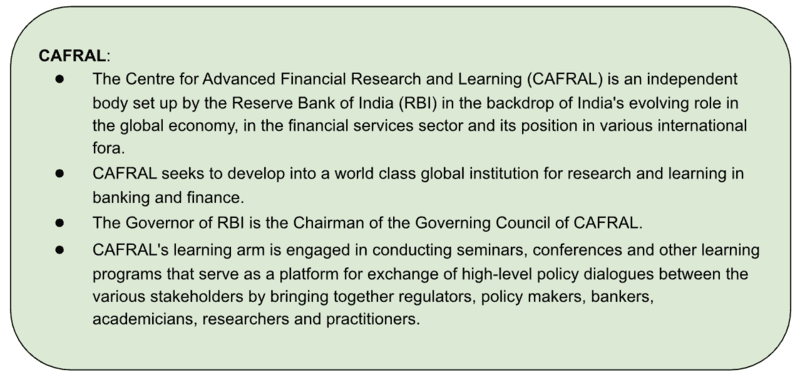GS Paper III
News Excerpt:
The Centre for Advanced Financial Research and Learning (CAFRAL), set up by the RBI, has raised concern over the rise in bank financing for non-banking finance companies.
CAFRAL Report:
- Key highlights:
- There is a significant fall in secured borrowings and a marginal increase in unsecured borrowings, showing increased exposure to riskier finance.
- Both secured and unsecured bank borrowings fall and unsecured debentures increase.
- There is also a significant fall in reserves and surplus indicating that buffers grow thinner.
- The evidence also shows risk build-up on the assets sides on the NBFC balance sheet following a contractionary monetary policy shock.
- On the assets side, the shrinkage is due to a fall in secured loans and advances even as unsecured ones see a marginal increase. There is also an increase in capital market exposure driven by an increase in equity holdings.
- CAFRAL warned against the many fake/ illegal lending apps in the marketplace, stating that these apps pose legal and collect information that they could use maliciously.
- Users downloading a lending app cannot verify whether it is legal. Similarly, fake customer care call scams collect and misuse personal and sensitive information from users.
- The report said there are concerns about the spillover of losses from the online lending activities to the traditional banking sector.
- The stronger the linkages between the traditional lending and online lending sectors, the larger the spillover.
- Many apps are increasingly asking consumers for critical information such as location, camera, contacts, making phone calls, audio, etc.
- There are many avenues for misusing this information that can compromise consumer safety and privacy.
- FinTech and Digital Lending:
- FinTech has widened the range of products available to customers and expanded its distribution channels.
- Across 80 application stores, nearly 1100 lending apps were available for Indian Android users,
- Currently, the share of the digital lending in the overall credit pie is small and does not immediately warrant panic.
- However, the sector has been growing non-linearly, thanks to the ease of scalability in platforms.
- Therefore, it might be important to assess the potential stability risks digital lending would pose to the larger economy in the near future as it grows.
- Further, since the poor and the marginalized are an important market group segment that digital lending targets, any losses in digital lending have important implications for credit availability and financial inclusion for this group.
- NBFCs Data-Analytic:
- Banks’ exposure to NBFCs rose by 25.8 per cent to Rs 13.83 lakh crore as of August 2023 as against Rs 10.99 lakh crore a year ago, latest RBI data showed.
- After rapid expansion, the NBFC sector in India suffered two significant shocks – the fall of IL&FS in September 2018 and the DHFL collapse in June 2019 — which adversely affected market confidence in the sector.
- Non-bank lenders, given their access to novel credit delivery methods, provide credit to underserved borrower segments that are left behind in the credit access network by traditional banking.
- This is borne out by a large increase (2.75 times and 124.5 times, respectively, from 2014 to 2019) in the size of the retail lending loan books of NBFCs and FinTech lenders, much larger than the loan growth for traditional banks.
- Analysing the NBFC sector:
- Predatory lending through deceptive lending practices or onerous loan terms can have detrimental welfare consequences, especially for disadvantaged households.
- Regulators and policymakers, thus, need to balance encouraging innovation and promoting borrower welfare.
- Retail loans, usually in the form of credit cards, housing or payday loans, can have adverse effects on household balance sheets.
- Furthermore, algorithmic techniques can also make biased lending decisions that can keep worthy borrowers out of formal finance.
- FinTech lending to exceed bank lending by 2030:
- Within the NBFCs, FinTech lending is projected to exceed traditional bank lending by 2030.
- FinTech lenders have captured a substantial share of the consumer and retail market.
- The rapid expansion in FinTech lending has led to the birth of a number of FinTech start-ups.
- Of the 14,000 newly funded start-ups between 2016 and 2021, close to half belonged to the FinTech industry.

Prelims PYQ
Q. The Reserve Bank of India (RBI) acts as a bankers' bank. This would imply which of the following? (UPSC 2012)
1) Banks retain their deposits with the RBI.
2) The RBI lends funds to the commercial banks in times of need.
3) The RBI advises the commercial banks on monetary matters.
Select the correct answer using the codes given below:
(a) 2 and 3 only
(b) 1 and 2 only
(c) 1 and 3 only
(d) 1, 2 and 3


